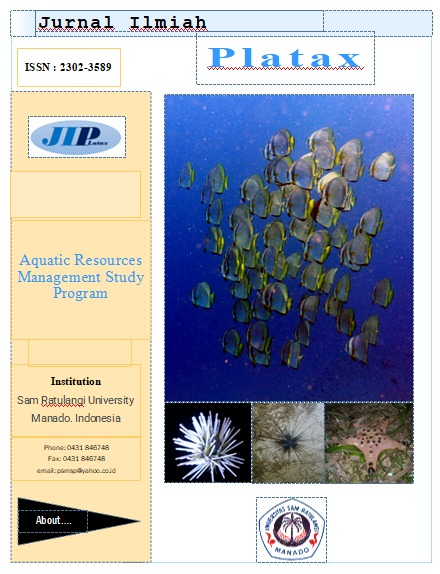Attachment Of Macrobenthos Larvae To Organic And Non-Organic Substrates
DOI:
https://doi.org/10.35800/jip.v12i1.52205Keywords:
Pasting, substrate;, Tiwoho Coast, Malalayang CoastAbstract
The objectives of this study are 1) to Identify the specimen of macrobenthos attached to the substrate provided in 2 locations. 2) to determine the type of substrate attached by the larvae at both sites. 3) to determine the density of Macrobenthos attached to the substrate provided at 2 sites. A plywood plate had 16 holes with a diameter of 1 cm each that had been randomly filled with organic substrates, namely coconut fibers, palm fibers, shells with 'bysus' threads, and non-organic substrates in the form of plastic ropes. Each substrate has four replicates. The plywood plate with 3 replicates was placed in each station. The plate was removed and taken to the laboratory after 1 month. The identification up to family, genus, and species as well as the density of each species were applied. The results showed that not only the larvae of Septifer bilocularis attached to organic and non-organic substrates, but six species of larvae were also identified. The sizes of new settler macrobenthos from 2 mm to 1 cm attached on organic and non-organic substrates were identified. The density of new settlers species attached to substrates varied from 0.03 – 0.5 individuals/cm2. The new settlers identified 7 species in Tiwoho and 3 species in Malalayang.
Keywords: Settlement, Substrate, Tiwoho Coast, Malalayang Coas.
Abstrak
Tujuan dari penelitian ini adalah 1) Mengidentifikasi jenis-jenis makrobenthos yang menempel pada substrat yang disediakan di 2 lokasi. 2) Mengidentifikasi jenis substrat sebagai tempat penempelan larva macrobenthos di kedua lokasi, dan 3) Menentukan kepadatan jenis Makrobenthos pada substrat yang disediakan di 2 lokasi. Triplek (plate) memiliki 16 lubang dengan ukuran diameter masing-masing 1 cm yang telah diisi secara acak dengan substrat organik yaitu serabut kelapa, serabut ijuk, cangkang ber ‘byssus’, serta substrat non organik berupa tali plastik. Masing-masing substrat ini memiliki 4 ulangan. Selanjutnya, plate, masing-masing dengan 3 ulangan ditempatkan di setiap intertidal, Towoho dan Malalayang. Plate diangkat setelah 1 bulan, yang dibawah ke laboratorium untuk foto dan diidentifikasi baik di tingkat jenis, genus, ataupun family. Hasil penelitian menunjukkan bahwa tidak hanya larva kerang Septifer bilocularis (Linnaeus, 1758), yang menempel pada substrat organik dan non organik, tetapi ditemukan larva macrobenthos lainnya, yaitu 2 jenis dari Cerithum egenum (Gould, 1849), dan Calcarina defranci d'Orbigny, 1826, 2 family/genus, yaitu: Canthocamptidae dan Portunidae, dan 2 klass, yaitu : Polychaeta dan Demospongae. Teridentifikasi jenis larva makro benthos yang baru menempel pada substrat substrat organik dan non-organik dengan ukuran yang bervariasi, yaitu dari 2 mm – 1 cm. Kepadatan jenis macrobenthos yang baru menempel adalah dari 0.03 – 0.5 individu/cm2. Ada 7 jenis teridentifkasi di lokasi Tiwoho, dan 3 jenis teridentifkasi di Malalayang
Kata kunci: Penempelan, Substrat, Pesisir Tiwoho, Pesisir Malalayang
References
Ompi, M. (2010). Ssttlemen Behavior and Size of Mussel Larvae From The Family Mytilidae (Brachidontes erosus (Lamarck, 1819), Brachidontes rostratus (Dunker, 1857), Trichomya hirsutus (Lamarck, 1819), and Mytilusgalloprovincialis Lamarck, 1819.Journal of Coastal Development. 13 (3): 215-227.
Ompi, M., Svanne, I. (2018). Comparing Spawning, Larval Development, and Recruitment of Four Mussel Species (Bivalvia:Mytilidae) From South Australia. Aquaculture, Aquarium, Conservation & Legislation. 11 (3), 576-588.
Palit dkk (2022); Rekrutmen Kerang Tropis, Septiver billocuris di pesisir Tiwoho.
Wagiu, F. J., Ompi, M., Kaligis, E. Y., Rimper, J. R., Roeroe, K. A., & Manginsela, F. B. (2022). PENEMPELAN KERANG Septifer bilocularis PADA SUBSTRAT DALAM AGREGASI KERANG DI DAERAH PASANG SURUT PESISIR TIWOHO. Jurnal Pesisir dan Laut Tropis, 10(3), 223-230.
Downloads
Published
How to Cite
Issue
Section
License
Copyright (c) 2024 Hans S. R. P. Saragih, Medy Ompi, Erly Yosef Kaligis, Farnis B. Boneka Boneka, Veibe Warouw, Darus Sa’adah Johanis Paransa

This work is licensed under a Creative Commons Attribution-NonCommercial 4.0 International License.
COPYRIGHT
Authors who publish with this journal agree to the following terms:
Authors hold their copyright and grant this journal the privilege of first publication, with the work simultaneously licensed under a Creative Commons Attribution License that permits others to impart the work with an acknowledgment of the work's origin and initial publication by this journal.
Authors can enter into separate or additional contractual arrangements for the non-exclusive distribution of the journal's published version of the work (for example, post it to an institutional repository or publish it in a book), with an acknowledgment of its underlying publication in this journal.
Authors are permitted and encouraged to post their work online (for example, in institutional repositories or on their website) as it can lead to productive exchanges, as well as earlier and greater citation of the published work (See The Effect of Open Access).




















